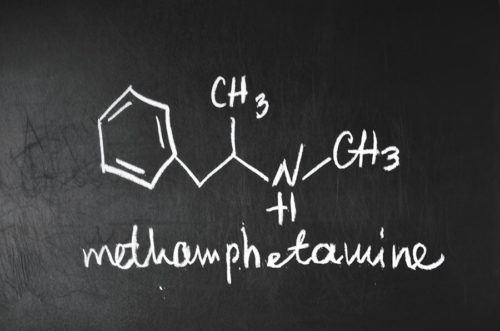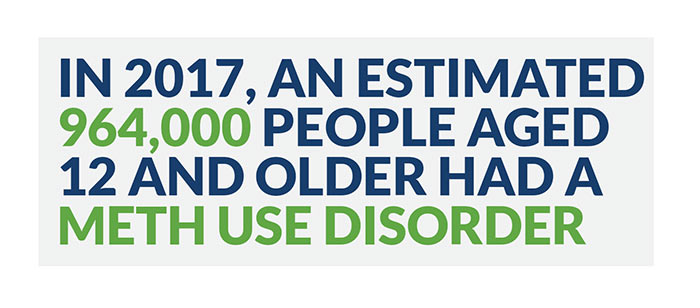Read the latest and greatest from our team
of incredible specialists.

Beach House Recovery Center » Blog » Meth Addiction and Abuse Statistics
Methamphetamine, or meth, is a highly addictive and extremely toxic stimulant drug with a high potential for abuse. Meth addiction is one of the most heartbreaking and devastating substance use disorders (SUDs) today, accounting for dramatic increases in current users, numbers of meth users needing treatment, and escalating meth overdose deaths.
Not only can meth use lead to psychological or physical dependence, it can result in life-long damage to the human body and brain. Meth is chemically similar to amphetamine, a drug that may be prescribed for treatment of the sleep disorder narcolepsy, and attention-deficit hyperactivity disorder (ADHD).

Data from the 2017 National Survey on Drug Use and Health (NSDUH) show that about 774,000 people aged 12 and older were current meth users in 2017, about 0.3 percent of the population. That’s up starkly from the 667,000 people age 12 and older who were current meth users in 2016. Current (past month) meth users in 2017 versus 2016 segmented by age groups:
According to a statistic from the Office of National Drug Control Policy, 90 percent of Americans with a problem of substance abuse started drinking, smoking and doing drugs before the age of 18.
 Clinically significant impairment caused by the chronic use of meth is called methamphetamine use disorder or meth addiction. The disorder is characterized by increasing or persistent use, restlessness, hyperactivity, numbness, emotional and physical withdrawal, bizarre behavior, hallucinations, isolation from family and friends, health problems, and difficulties at home, work, or school. In 2017, an estimated 964,000 people aged 12 and older had a meth use disorder, meaning they met diagnostic criteria for meth dependence or abuse. As context, in 2016, an estimated 626,000 people age 12 and older had a heroin use disorder.
Clinically significant impairment caused by the chronic use of meth is called methamphetamine use disorder or meth addiction. The disorder is characterized by increasing or persistent use, restlessness, hyperactivity, numbness, emotional and physical withdrawal, bizarre behavior, hallucinations, isolation from family and friends, health problems, and difficulties at home, work, or school. In 2017, an estimated 964,000 people aged 12 and older had a meth use disorder, meaning they met diagnostic criteria for meth dependence or abuse. As context, in 2016, an estimated 626,000 people age 12 and older had a heroin use disorder.
Among the 964,000 people in 2017 with a meth use disorder, 24,000 were adolescents, while 188,000 were young adults, and 751,000 were adults aged 26 and older. In 2016, those numbers were: 10,000 adolescents, 135,000 young adults, and 539,000 adults.
A 2015 study funded by the NIDA and carried out by researchers at the University of California, Los Angeles (UCLA), found high rates of dental and gum disease among meth users. Some 96 percent of the 571 users surveyed had dental cavities, while 58 percent suffered untreated tooth decay. Even more shocking was the fact that a mere 23 percent retained all their natural teeth, compared with 48 percent of the general population.
Moderate to heavy meth users, according to the study, were twice as likely to experience dental cavities than light meth users. Those over 30, women, and current smokers were “disproportionately” affected by dental and periodontal disease (gum disease). Furthermore, 40 percent of study participants expressed embarrassment over the appearance of their teeth or gums.
According to statistics compiled by the National Center for Health Statistics and the Centers for Disease Control and Prevention (CDC), meth overdose deaths in the United States are on a steep upward trajectory. Taking high doses of meth can result in death from heart attack, stroke, or multiple organ failures caused by extreme hyperthermia (elevated body temperature or overheating).
Provisional data from 22 reporting jurisdictions on drug overdose deaths for the 12-month ending period (Jan. 2016 vs, Jan. 2017) compiled by the CDC’s National Center for Health Statistics, National Vital Records System, show some dramatic increases.
Reporting jurisdictions with the highest drug overdose deaths (including all drugs, not just meth) include:
Jurisdictions showing a decrease in drug overdose deaths include Nebraska, down 8 percent, Wyoming and Washington, each down three percent.
Psychostimulant (including meth) overdose deaths in the U.S. and seven jurisdictions, Jan. 2016 vs. Jan. 2017:
In Ohio, the Department of Health reported that the rate of overdose deaths involving methamphetamine and other psychostimulants, as well as cocaine-related overdose deaths increased substantially in 2017. That year, 537 overdose deaths from psychostimulants such as methamphetamine were recorded. According to reports, methamphetamine, as well as cocaine and heroin, are often laced with deadly fentanyl, which may be directly responsible for overdose deaths.
In Texas, 2,995 people died from drug overdoses in 2017, with the top two causes of fatal overdoses from cocaine and methamphetamine. Cocaine overdose deaths in Bexar County, TX increased from 40 in 2015 to 60 in 2017, while fatal methamphetamine overdoses rose from 30 to nearly 80 during that time period. State news reports blame Mexican cartels for the increasing meth availability in the state, with efforts by Texas lawmakers to curb production of meth by limiting sales of pseudoephedrine, a cold/allergy medication used to make meth, doing little to halt availability of meth.
In King County, Washington, an area that includes Seattle, methamphetamine deaths have experienced a steady rise over the past five years, according to a DEA Bulletin issued in August 2017. The state’s most populous county recorded 109 (30 percent) meth deaths, out of 360 total drug deaths in 2016. The DEA reports that the meth responsible for the overdose deaths in King County is produced in Mexico and smuggled across the Southwest border. Meth users in King County have begun combining meth with heroin, which has contributed to the sharp increase in deaths in the county.
In New York City, meth overdose deaths continue to skyrocket, with at least some of the deaths attributed to combining it with deadly fentanyl. Reports that drug traffickers, often aligned with Mexican cartels, are manufacturing more potent and purer meth and importing it to the United States. Whereas meth overdose was a concerning cause of death among HIV-positive gay white men in New York 15 years ago, today the demographics of meth overdose victims is much more diverse.
For more about methamphetamine addiction and recovery, check out these articles:
Sources:
Above the Influence. “Drug Facts.” “Meth.” Retrieved from https://abovetheinfluence.com/drugs/meth/#facts
CDC. National Center for Health Statistics. National Vital Statistics System. “Provisional Counts of Drug Overdose Deaths, as of 8/16/2017.” Retrieved from https://www.cdc.gov/nchs/data/health_policy/monthly-drug-overdose-death-estimates.pdf
Centers for Disease Control and Prevention. “Morbidity and Mortality Weekly Report (MMWR).” “Illicit Drug Use, Illicit Drug Use Disorders, and Drug Overdose Deaths in Metropolitan and Nonmetropolitan Areas – United States.” Retrieved from https://www.cdc.gov/mmwr/volumes/66/ss/ss6619a1.htm?s_cid=ss6619a1_w
Centers for Disease Control and Prevention. “Morbidity and Mortality Weekly Report (MMWR).” “Increases in Drug and Opioid Overdose Deaths – United States, 2000-2014.” Retrieved from https://www.cdc.gov/mmwr/preview/mmwrhtml/mm6450a3.htm?s_cid=mm6450a3_w
DEA Bulletin. “Methamphetamine Fatalities on the Rise in King County, Washington.” Retrieved from https://www.dea.gov/sites/default/files/2018-07/BUL-187-17.pdf
Gay City News. “Meth Deaths Surging Again in New York.” Retrieved from https://www.gaycitynews.nyc/stories/2018/5/w29718-meth-deaths-surging-new-york-2018-03-08.html
Journal of the American Dental Association. “Dental disease patterns in methamphetamine users.” Retrieved from https://jada.ada.org/article/S0002-8177(15)00977-0/fulltext
LMT Online. “Increase of drug overdoses in Texas alarming.” Retrieved from https://www.lmtonline.com/opinion/editorials/article/Increase-of-drug-overdoses-in-Texas-alarming-13221793.php
National Institute on Drug Abuse. “High rates of dental and gum disease occur among methamphetamine users.” Retrieved from https://www.drugabuse.gov/news-events/news-releases/2015/11/high-rates-dental-gum-disease-occur-among-methamphetamine-users
National Institute on Drug Abuse. “Methamphetamine.” “Brief Description.” Retrieved from https://www.drugabuse.gov/drugs-abuse/methamphetamine
Ohio Department of Health. “2017 Ohio Drug Overdose Data: General Findings.” “Fentanyl and Related Drugs Drove Increase in Overdose Deaths Along With Rising Cocaine, Methamphetamine and Combined Drug Use.” Retrieved from https://www.scribd.com/document/389603751/Report-on-2017-Ohio-overdose-deaths
Pharmacology & Therapeutics. “Methamphetamine-induced toxicity: An updated review on issues related to hyperthermia.” Retrieved from https://www.sciencedirect.com/science/article/pii/S0163725814000965
Substance Abuse and Mental Health Services Administration. “Key Substance Use and Mental Health Indicators in the United States: Results from the 2016 National Survey on Drug Use and Health.” “Substance Use Disorders in the Past Year.” “Methamphetamine Use Disorder.” Retrieved from… https://www.samhsa.gov/data/sites/default/files/NSDUH-FFR1-2016/NSDUH-FFR1-2016.htm#opioid2
Substance Abuse and Mental Health Services Administration. “Key Substance Use and Mental Health Indicators in the United States: Results from the 2016 National Survey on Drug Use and Health.” “Illicit Drug Use in the Past Month: Methamphetamine Use.” Retrieved from https://www.samhsa.gov/data/sites/default/files/NSDUH-FFR1-2016/NSDUH-FFR1-2016.htm#tx2
Substance Abuse and Mental Health Services Administration. “Key Substance Use and Mental Health Indicators in the United States: Results from the 2017 National Survey on Drug Use and Health.” “Illicit Drug Use in the Past Month: Methamphetamine Use.” Retrieved from https://www.samhsa.gov/data/report/2017-nsduh-annual-national-report
Substance Abuse and Mental Health Services Administration. “Key Substance Use and Mental Health Indicators in the United States: Results from the 2016 National Survey on Drug Use and Health.” “Substance Use Disorders in the Past Year.” “Methamphetamine Use Disorder.” Retrieved from https://www.samhsa.gov/data/sites/default/files/NSDUH-FFR1-2016/NSDUH-FFR1-2016.htm#tx2
Substance Abuse and Mental Health Services Administration. “Key Substance Use and Mental Health Indicators in the United States: Results from the 2017 National Survey on Drug Use and Health.” “Substance Use Disorders in the Past Year.” “Methamphetamine Use Disorder.” Retrieved from https://www.samhsa.gov/data/report/2017-nsduh-annual-national-report
Substance Abuse and Mental Health Services Administration. “Key Substance Use and Mental Health Indicators in the United States: Results from the 2017 National Survey on Drug Use and Health.” “Need for Substance Use Treatment.” Retrieved from https://www.samhsa.gov/data/report/2017-nsduh-annual-national-report
Substance Abuse and Mental Health Services Administration. “Key Substance Use and Mental Health Indicators in the United States: Results from the 2017 National Survey on Drug Use and Health.” “Receipt of Substance Use Treatment.” Retrieved from https://www.samhsa.gov/data/report/2017-nsduh-annual-national-report
U.S. Department of Justice, Drug Enforcement Agency. “Drugs of Abuse: Methamphetamine.” Retrieved from https://www.dea.gov/sites/default/files/2018-06/drug_of_abuse.pdf
Whether you’re researching for yourself or a loved one, Beach House can help. We understand that this is a serious time in your life and that the treatment center you choose matters. We want you to feel comfortable and empowered to make the right decision for yourself, a friend, or a family member. This is why a counselor is waiting and available to answer your questions and help put your mind at ease regarding the next steps. Many of the staff at Beach House have walked in your shoes. If you feel you’re ready or want more information about how to help a loved one, we can help today. You can also learn why we are voted the #1 rehab for addiction treatment in Florida.
We accept most major insurance plans and can verify your benefits quickly and confidentially.
We’re committed to helping you access the care you need, our admissions counselors can guide you through your coverage options and available resources.





"*" indicates required fields